Baron, Peter
Killed in Flying Accident 1954-09-29
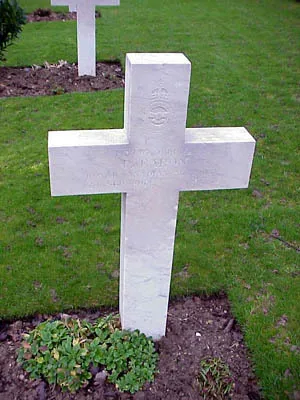

Birth Date: 1933
Born:
Son of Squire and Isabel Baron of Fernie, British Columbia.
Home:
Enlistment:
Enlistment Date: Unknown
Service
RCAF
Unit
434 Sqn- Squadron
In Excelsis Vincimus We conquer in the Heights
Base
Rank
Flying Officer
Position
Flying Officer
Service Numbers
211441
North American Sabre F-86 CAC FJ-2 FJ-3 CA-27 CL-13
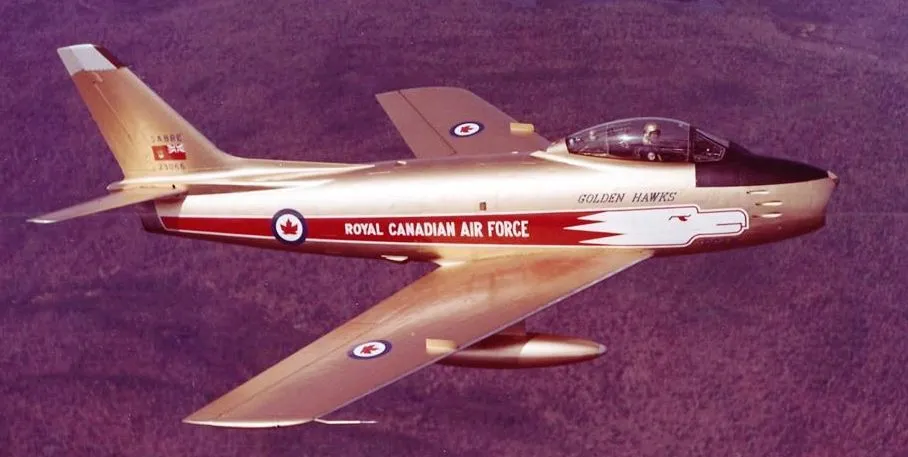
Canadair CL-13 Sabre Mk. 5 (Serial No. 23066), Golden Hawks
The North American F-86 Sabre, sometimes called the Sabrejet, is a transonic jet fighter aircraft. Produced by North American Aviation, the Sabre is best known as the United States' first swept-wing fighter that could counter the swept-wing Soviet MiG-15 in high-speed dogfights in the skies of the Korean War (1950"“1953), fighting some of the earliest jet-to-jet battles in history. Considered one of the best and most important fighter aircraft in that war, the F-86 is also rated highly in comparison with fighters of other eras. Although it was developed in the late 1940s and was outdated by the end of the 1950s, the Sabre proved versatile and adaptable and continued as a front-line fighter in numerous air forces.
Its success led to an extended production run of more than 7,800 aircraft between 1949 and 1956, in the United States, Japan, and Italy. In addition, 738 carrier-modified versions were purchased by the US Navy as FJ-2s and -3s. Variants were built in Canada and Australia. The Canadair Sabre added another 1,815 aircraft and the significantly redesigned CAC Sabre (sometimes known as the Avon Sabre or CAC CA-27), had a production run of 112. The Sabre is by far the most-produced Western jet fighter, with a total production of all variants at 9,860 units.
The fighter-bomber version (F-86H) could carry up to 2,000 lb (907 kg) of bombs, including an external fuel-type tank that could carry napalm. Unguided 2.75-inch (70-millimeter) rockets were used on some fighters on training missions, but 5-inch (127 mm) rockets were later carried on combat operations. The F-86 could also be fitted with a pair of external jettisonable jet fuel tanks (four on the F-86F beginning in 1953) that extended the range of the aircraft. Both the interceptor and fighter-bomber versions carried six 0.50 in (12.7 mm) M3 Browning machine guns with electrically-boosted feed in the nose (later versions of the F-86H carried four 20 mm (0.79 in) cannon instead of machine guns). Firing at a rate of 1,200 rounds per minute, the 0.50-inch guns were harmonized to converge at 1,000 ft (300 m) in front of the aircraft, using armor-piercing (AP) and armor-piercing incendiary (API) rounds, with one armor-piercing incendiary tracer (APIT) for every five AP or API rounds. The API rounds used during the Korean War contained magnesium, which were designed to ignite upon impact, but burned poorly above 35,000 ft (11,000 m) as oxygen levels were insufficient to sustain combustion at that height. Initial planes were fitted with the Mark 18 manual-ranging computing gun sight. The last 24 F-86A-5-Nas and F-86Es were equipped with the A-1CM gunsight-AN/APG-30 radar, which used radar to automatically compute a target's range, which later proved to be advantageous against MiG opponents over Korea.Wikipedia
 Wikipedia North American F-86 Sabre
Wikipedia North American F-86 Sabre
 YouTube F-86 Sabre Aerobatics - No Music! - Airshow London 2018
YouTube F-86 Sabre Aerobatics - No Music! - Airshow London 2018



434 Sqn In Excelsis Vincimus ("Bluenose")
History of the Squadron during World War II (Aircraft: Halifax V, III, Lancaster I, III)
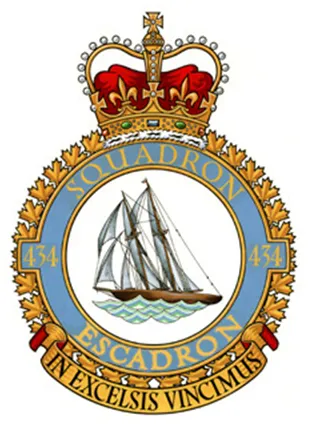
The unit was first formed at RAF Tholthorpe, Yorkshire, UK on 13 June 1943, flying the Handley Page Halifax Mk V aircraft. It was the 31st squadron and the 13th Bomber unit formed overseas. From its initiation it was part of the No 6 (RCAF) Group of RAF Bomber Command. On 13 August 1943 it flew its first operational sortie, a bombing raid across the Alps to Milan, Italy. In May 1944 the unit received Halifax Mk IIIs to replace its Mk Vs. The squadron was adopted by the Rotary Club of Halifax, Nova Scotia and to show its connection to the city adopted the nickname "Bluenose Squadron", the common nickname for people from Nova Scotia and a tribute to the schooner Bluenose; an image of the schooner appears on the squadron badge.
The squadron moved to RAF Croft, Yorkshire in December 1943 and re-equipped with Avro Lancaster Mk Is and Mk Xs in December 1944. After VE Day the squadron was earmarked for the Tiger Force to carry on the war against Japan, but was never deployed to the Far East because of the Japanese surrender. The unit was disbanded at Dartmouth, Nova Scotia on 5 September 1945.
During World War II the unit flew 198 missions, including 179 bombing, 17 mine laying, one diversionary and one sea search. This was made up of a total of 2582 individual aircraft sorties, including 45 prisoner of war airlift sorties. It flew 14,622 operational flying hours and dropped 10,358 tons of bombs plus 225 mines. The squadron accounted for seven enemy aircraft destroyed along with two probable and four damaged. 434 Squadron suffered 75 aircraft lost, 484 aircrew operational casualties, including 34 killed, 313 presumed dead, 121 made prisoners and 16 who evaded capture and escaped. Unit personnel received six bars to the Distinguished Flying Cross, 108 DFCs, six Distinguished Flying Medals, one British Empire Medal and seven Mentions in Despatches. Battle Honours were: English Channel and North Sea 1943-44, Baltic 1943-44, Fortress Europe 1943-44, France and Germany 1944-45, Biscay Ports 1944, Ruhr 1943-45, Berlin 1943-44, German Ports 1944-45, Normandy 1944, Rhine.Wikipedia, Kostenuk &Griffin .
 Squadron History (Bomber Command Museum PDF)
Squadron History (Bomber Command Museum PDF)
Maps for Movements of 434 Squadron 1943-45
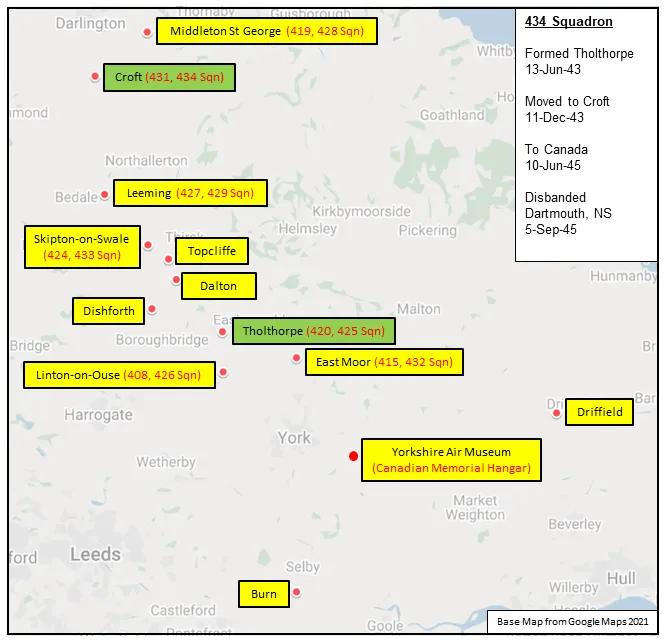
434 Squadron History Summary 1943-45
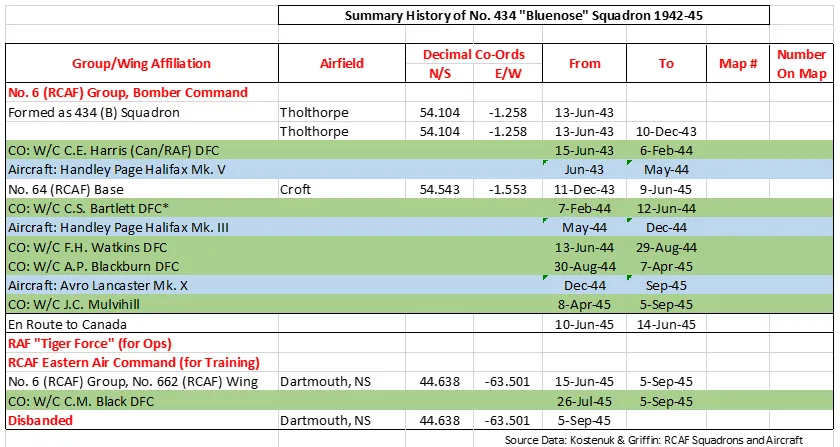
History of the Squadron Post-WWII (Aircraft: Sabre 2, 5, 6, Starfighter, Freedom Fighter, Challenger)
The squadron was re-formed as a fighter unit at Uplands, Ontario on 1 July 1952, flying Canadiar Sabre aircraft. It joined No.3 (Fighter) Wing at Zweibrücken, Germany in March 1953. It was selected to be one of the eight squadrons to be equipped with the CF-104 Starfighter in a Strike Attack role. Accordingly, it was deactivated on 15 January 1963 and reactivated on 8 April. The squadron was deactivated on 1 Mar 1967.
The unit was re-formed as 434 Operational Training Squadron at CFB Cold Lake, Alberta on 15 February 1968 as the operational training unit for the Canadair CF-5 Freedom Fighter. The squadron later gave up its OTU duties to 419 Squadron and became an operational squadron, moving to CFB Bagotville on 15 July 1982, later moving to CFB Chatham in July 1985. It was again disbanded on 17 March 1989. The unit was again re-formed as 434 Composite Squadron at CFB Shearwater on 4 July 1992. The name was changed to 434 Combat Support Squadron and the unit moved to CFB Greenwood in mid-1995, flying the CC-144 Challenger and Canadair CT-133 Silver Star in the electronic warfare role. The squadron was once again disbanded there in May 2000.
The squadron was reactivated in May 2018 at CFB Trenton as a test and evaluation unit. For details see
. Choloy War Cemetery, Choloy, Meurthe-Et-Moselle, France
Choloy War Cemetery, Choloy, Meurthe-Et-Moselle, France Canadian Virtual War Memorial
Canadian Virtual War Memorial Harold A Skaarup Web Page
Harold A Skaarup Web Page